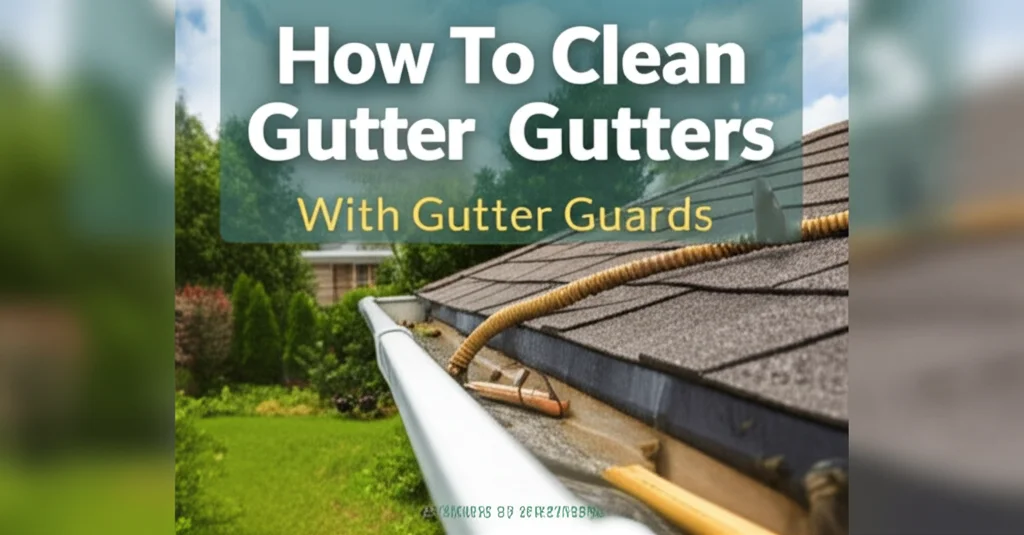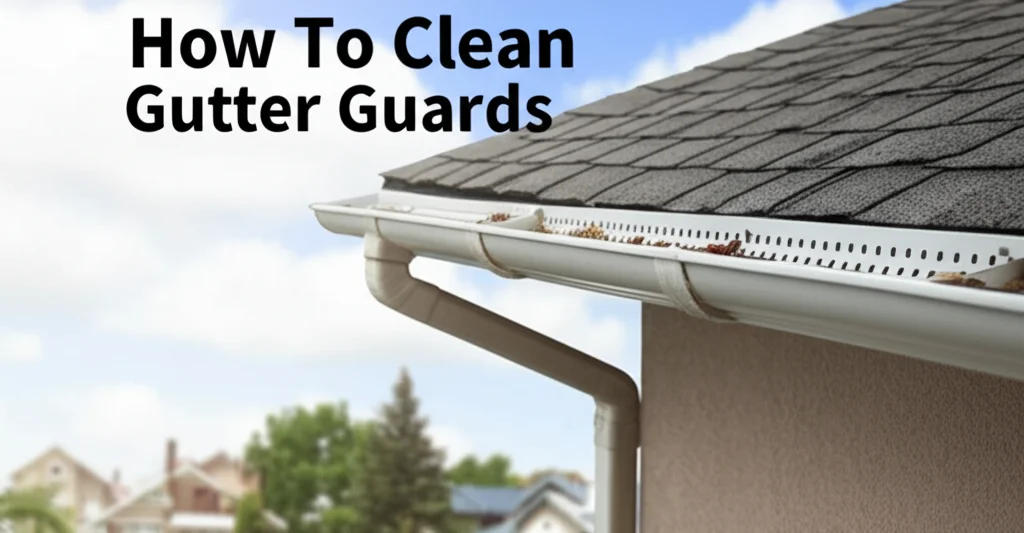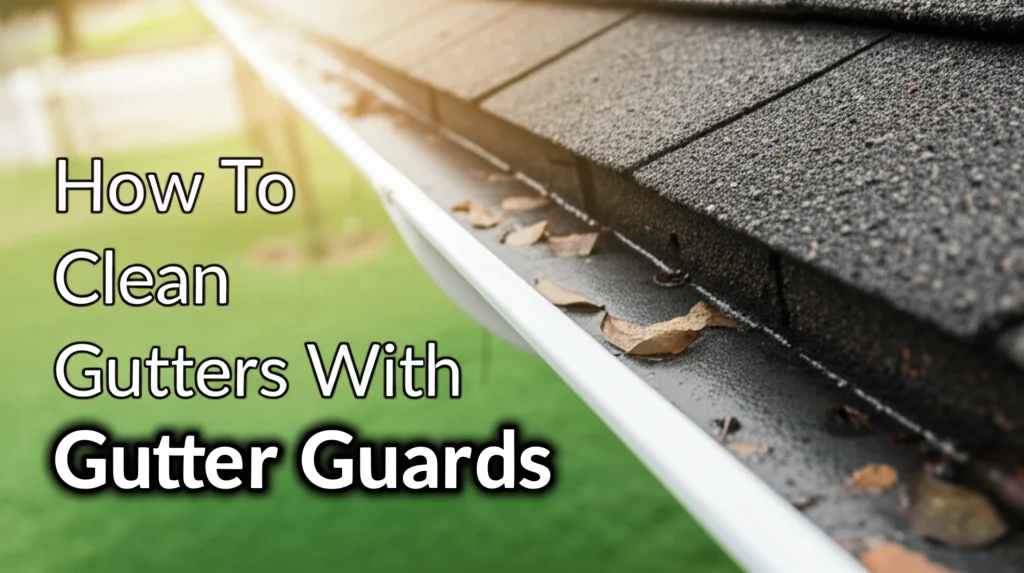· Home Maintenance · 6 min read
How To Clean Out Gutters With Gutter Guards

Keeping Your Gutters Clear: How To Clean Out Gutters With Gutter Guards
Have you invested in gutter guards, thinking they’d eliminate gutter cleaning altogether? While gutter guards significantly reduce debris buildup, they don’t make gutter cleaning obsolete. Leaves, pine needles, and other small particles can still accumulate on top of the guards or find their way inside. This article will guide you through how to clean out gutters with gutter guards, ensuring your home’s foundation and exterior remain protected from water damage. We’ll cover everything from the tools you’ll need to the best techniques for a thorough clean, and even address common problems you might encounter.
Quick Answer: Even with gutter guards, you need to clean your gutters at least twice a year – spring and fall – to remove accumulated debris on top of the guards and any that bypasses them. This prevents clogs, water damage, and costly repairs.
Takeaway:
- Regularly inspect your gutters and guards.
- Remove debris from on top of the guards.
- Flush gutters with water to clear any internal buildup.
- Address any sagging or damaged sections promptly.
Why Gutter Guards Aren’t a “Set It and Forget It” Solution
Gutter guards are a fantastic investment for any homeowner. They prevent large debris like leaves and twigs from entering your gutters, reducing the frequency of cleaning. However, they aren’t a perfect solution. Smaller debris, such as pine needles, shingle granules, and pollen, can still accumulate on the surface of the guards or slip through the gaps. Over time, this buildup can restrict water flow, leading to clogs and potential water damage to your roof, siding, and foundation. Think of gutter guards as a preventative measure, not a complete replacement for regular maintenance.
Gathering Your Tools for Gutter Cleaning
Before you start, having the right tools will make the job much easier and safer. You don’t need a huge arsenal, but a few key items are essential. Safety should always be your top priority, so invest in a sturdy ladder and consider wearing gloves and eye protection. Here’s a checklist of what you’ll need:
- Ladder: A stable, adjustable ladder is crucial for reaching your gutters safely.
- Gloves: Protect your hands from dirt, debris, and potential sharp edges.
- Safety Glasses: Shield your eyes from falling debris.
- Gutter Scoop: A plastic scoop designed for removing debris from gutters. Avoid metal scoops, as they can damage the gutter lining.
- Garden Hose with Spray Nozzle: For flushing out remaining debris.
- Leaf Blower (Optional): Can be used to clear debris from the top of the gutter guards.
- Bucket: To collect the removed debris.
- Plumber’s Snake or Wire Hanger: For dislodging stubborn clogs.
Inspecting Your Gutter Guards for Damage
Before you start cleaning, take a moment to inspect your gutter guards for any damage. Look for bent or broken sections, loose fasteners, or areas where the guards are pulling away from the gutter. Damaged guards won’t function effectively and can actually cause clogs by creating pockets where debris accumulates. Addressing these issues promptly will prevent further problems. If you find significant damage, consider repairing or replacing the affected sections. You can find replacement parts at most home improvement stores.
Cleaning Debris From On Top of the Gutter Guards
This is often the most significant part of the cleaning process, even with functioning gutter guards. Leaves, twigs, and other debris tend to accumulate on the surface of the guards, restricting water flow. You can remove this debris using a leaf blower, a gutter scoop, or simply by hand. Start at one end of the gutter and work your way along, carefully removing all visible debris. Pay close attention to areas around downspouts, as these tend to collect more debris. Removing this surface debris will dramatically improve the performance of your gutter guards.
Flushing Out Gutters After Removing Surface Debris
Once you’ve cleared the debris from the top of the guards, it’s time to flush out the gutters themselves. Use a garden hose with a spray nozzle to direct water into the gutters, starting at the end furthest from the downspout. The water will help to dislodge any remaining debris that has bypassed the guards and accumulated inside. Work your way towards the downspout, ensuring that the water flows freely. If you encounter any areas where the water is backing up, use a plumber’s snake or wire hanger to dislodge the clog. You can also find more information on how to deal with clogged downspouts here.
Dealing with Stubborn Clogs and Blockages
Sometimes, despite your best efforts, stubborn clogs can form in your gutters. These clogs can be caused by a buildup of organic matter, bird nests, or even small objects that have fallen into the gutters. If flushing with water doesn’t resolve the issue, try using a plumber’s snake or wire hanger to break up the clog. Insert the tool into the downspout and gently twist and push to dislodge the blockage. Be careful not to damage the gutter lining. If you’re unable to clear the clog yourself, you may need to call a professional gutter cleaning service. Remember, preventing water damage is always cheaper than repairing it. You might also find helpful tips on cleaning other areas of your home here.
FAQ About Cleaning Gutters With Gutter Guards
Q: How often should I clean my gutters with gutter guards?
A: At least twice a year – once in the spring after trees have finished blooming and again in the fall after the leaves have fallen. However, if you live in an area with a lot of pine trees or other debris-producing vegetation, you may need to clean them more frequently.
Q: What type of gutter guard is the easiest to clean?
A: Reverse curve gutter guards are generally the easiest to clean, as debris tends to fall off them naturally. However, all types of gutter guards require some level of maintenance.
Q: Can I use a pressure washer to clean my gutters?
A: While it’s possible to use a pressure washer, it’s generally not recommended. The high pressure can damage the gutters and guards. A garden hose with a spray nozzle is a much safer option.
Q: What should I do if my gutter guard is damaged?
A: Repair or replace the damaged section as soon as possible. A damaged gutter guard won’t function effectively and can lead to clogs and water damage.
Q: Is it safe to clean my gutters myself?
A: Cleaning gutters can be dangerous, especially if you’re working from a ladder. Always follow safety precautions, such as wearing gloves and eye protection, and using a stable ladder. If you’re not comfortable cleaning your gutters yourself, hire a professional.
Conclusion: Protecting Your Home with Proactive Gutter Maintenance
Cleaning out gutters with gutter guards is a crucial part of home maintenance. While gutter guards reduce the amount of debris that enters your gutters, they don’t eliminate the need for cleaning altogether. Regular inspection and cleaning – at least twice a year – will ensure that your gutters function properly and protect your home from costly water damage. Remember to prioritize safety, use the right tools, and address any damage promptly. By following these tips, you can keep your gutters clear and your home protected for years to come. If you’re looking for more ways to maintain a clean and healthy home, check out our guide on how to clean a stove top with baking soda.




